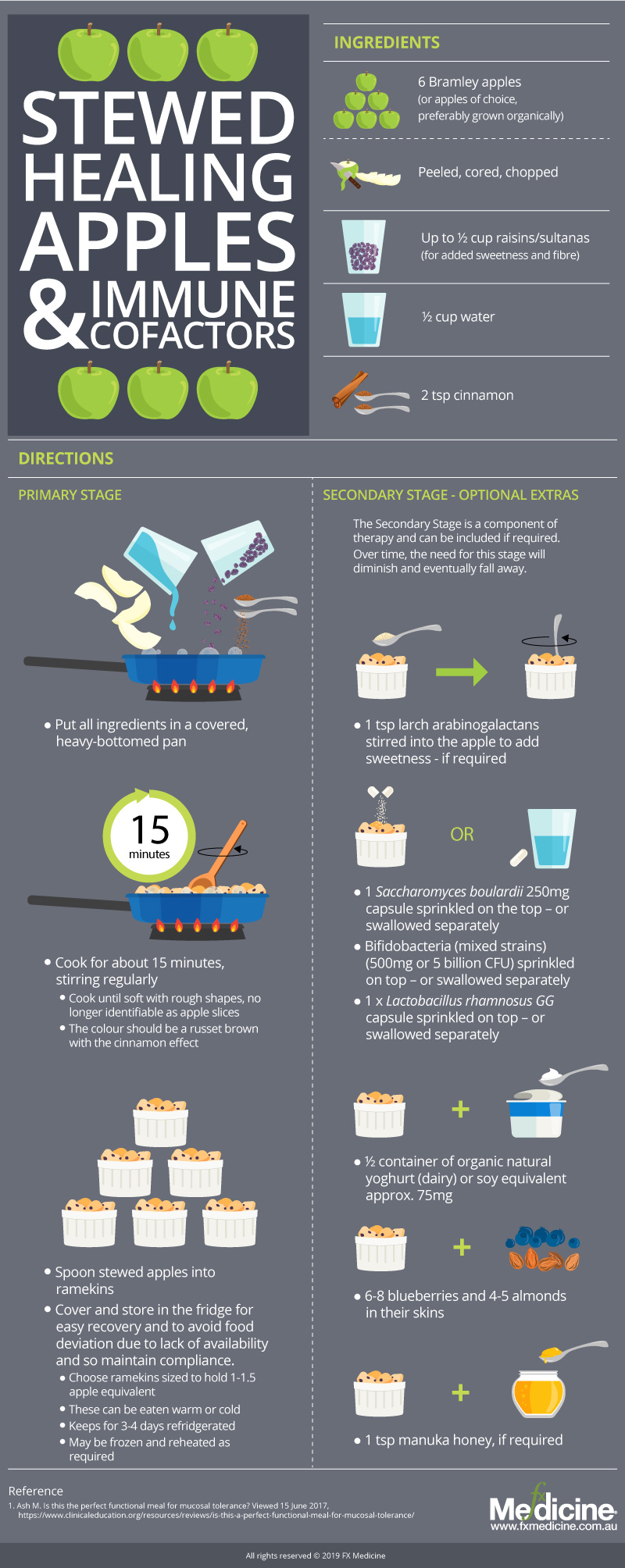
If you are an avid listener to the FX Medicine Podcast, you might have heard regular reference to the use of stewed apples as a key intervention in gut healing and repair.
Dr Mark Donohoe and Andrew Whitfield-Cook are huge fans of this easy, patient-friendly intervention that they were first introduced to by Michael Ash at the 2015 BioCeuticals Research Symposium.
We've had so many requests from our listeners about where to find the recipe for "Dr Mark's Stewed Apples" that we decided to consolidate it into an infographic that can be saved or shared as needed. This infographic is based on Michael Ash's scientific rationale for the use of apples as a functional food for mucosal healing.
CREATED AND PUBLISHED WITH PERMISSION from Michael Ash.
References
- Ebo DG, Bridts CH, Verweij MM, et al. Sensitization profiles in birch pollen-allergic patients with and without oral allergy syndrome to apple: lessons from multiplexed component-resolved allergy diagnosis. Clin Exp Allergy. 2010 Feb;40(2):339-47. Epub 2009 Aug 26. [Abstract]
- Rosenlund H, Kull I, Pershagen G, et al. Fruit and vegetable consumption in relation to allergy: Disease-related modification of consumption? J Allergy Clin Immunol. 2011 Jan 6. [Abstract]
- Kahle K, Kempf M, Schreier P, et al. Intestinal transit and systemic metabolism of apple polyphenols. Eur J Nutr. 2010 Dec 24. [Abstract]
- Titgemeyer EC, Bourquin LD, Fahey GC Jr, et al. Fermentability of various fiber sources by human fecal bacteria in vitro. Am J Clin Nutr. 1991 Jun;53(6):1418-24. [Abstract]
- Tsao R, Yang R, Xie S, et al. Which polyphenolic compounds contribute to the total antioxidant activities of apple? J Agric Food Chem. 2005 Jun 15;53(12):4989-95. [Abstract]
- Barbosa AC, Pinto Mda S, Sarkar D, et al. Varietal influences on antihyperglycemia properties of freshly harvested apples using in vitro assay models. J Med Food. 2010 Dec;13(6):1313-23. Epub 2010 Sep 27. [Abstract]
- Henríquez C, Speisky H, Chiffelle I, et al. Development of an ingredient containing apple peel, as a source of polyphenols and dietary fiber. J Food Sci. 2010 Aug 1;75(6):H172-81. [Abstract]
- Mikulic Petkovsek M, Slatnar A, Stampar F, et al. The influence of organic/integrated production on the content of phenolic compounds in apple leaves and fruits in four different varieties over a 2-year period. J Sci Food Agric. 2010 Nov;90(14):2366-78. [Abstract]
- Hecke K, Herbinger K, Veberic R, et al. Sugar-, acid- and phenol contents in apple cultivars from organic and integrated fruit cultivation. Eur J Clin Nutr. 2006 Sep;60(9):1136-40. Epub 2006 May 3. [Abstract]
- Briviba K, Stracke BA, Rüfer CE, et al. Effect of consumption of organically and conventionally produced apples on antioxidant activity and DNA damage in humans. J Agric Food Chem. 2007 Sep 19;55(19):7716-21. Epub 2007 Aug 16. [Abstract]
- Jung M, Triebel S, Anke T, et al. Influence of apple polyphenols on inflammatory gene expression. Mol Nutr Food Res. 2009 Oct;53(10):1263-80. [Abstract]
- Chun OK, Chung SJ, Claycombe KJ, Song WO. Serum C-reactive protein concentrations are inversely associated with dietary flavonoid intake in U.S. adults. J Nutr. 2008 Apr;138(4):753-60. [Abstract]
- Enomoto T, Nagasako-Akazome Y, Kanda T, et al. Clinical effects of apple polyphenols on persistent allergic rhinitis: A randomized double-blind placebo-controlled parallel arm study. J Investig Allergol Clin Immunol. 2006;16(5):283-9. [Abstract]
- Gemma C, Mesches MH, Sepesi B, et al. Diets enriched in foods with high antioxidant activity reverse age-induced decreases in cerebellar beta-adrenergic function and increases in proinflammatory cytokines. J Neurosci. 2002 Jul 15;22(14):6114-20. [Abstract]
- Lewis K, Lutgendorff F, Phan V, et al. Enhanced translocation of bacteria across metabolically stressed epithelia is reduced by butyrate. Inflamm Bowel Dis. 2010 Jul;16(7):1138-48. [Abstract]
- Sherry CL, Kim SS, Dilger RN, et al. Tappenden, Gregory G. Freund. Sickness behavior induced by endotoxin can be mitigated by the dietary soluble fiber, pectin, through up-regulation of IL-4 and Th2 polarization. Original Research Article. Brain, Behavior, and Immunity, Volume 24, Issue 4, May 2010, Pages 631-640. [Abstract]
- Rastmanesh R. High polyphenol, low probiotic diet for weight loss because of intestinal microbiota interaction. Chem Biol Interact. 2011 Jan 15;189(1-2):1-8. Epub 2010 Oct 15. Review. [Abstract]
- Selma MV, Espín JC, Tomás-Barberán FA. Interaction between phenolics and gut microbiota: role in human health. J Agric Food Chem. 2009 Aug 12;57(15):6485-501. Review. [Abstract]
- Monagas M, Khan N, Andrés-Lacueva C, et al. Dihydroxylated phenolic acids derived from microbial metabolism reduce lipopolysaccharide-stimulated cytokine secretion by human peripheral blood mononuclear cells. Br J Nutr. 2009 Jul;102(2):201-6. [Abstract]
- Chow J, Mazmanian SK. A pathobiont of the microbiota balances host colonization and intestinal inflammation. Cell Host Microbe. 2010 Apr 22;7(4):265-76. [Abstract]
- Shinohara K, Ohashi Y, Kawasumi K, et al. Effect of apple intake on fecal microbiota and metabolites in humans. Anaerobe. 2010 Oct;16(5):510-5. Epub 2010 Mar 19. [Abstract]
- Titgemeyer EC, Bourquin LD, Fahey GC Jr, et al. Fermentability of various fiber sources by human fecal bacteria in vitro. Am J Clin Nutr. 1991 Jun;53(6):1418-24. [Abstract]
- Kwon HK, Hwang JS, Lee CG, et al. Cinnamon extract suppresses experimental colitis through modulation of antigen-presenting cells. World J Gastroenterol. 2011 Feb 28;17(8):976-86. [Full Text]
- Qin B, Panickar KS, Anderson RA. Cinnamon: potential role in the prevention of insulin resistance, metabolic syndrome, and type 2 diabetes. J Diabetes Sci Technol. 2010 May 1;4(3):685-93. [Abstract]
- Urbanska AM, Paul A, Bhahena J, et al. Suppression of tumorigenesis: modulation of inflammatory cytokines by oral administration of microencapsulated probiotic yogurt formulation. Int J Inflam. 2010 Oct 31;2010:894972. [Abstract]
- Wagar LE, Champagne CP, Buckley ND, et al. Immunomodulatory properties of fermented soy and dairy milks prepared with lactic acid bacteria. J Food Sci. 2009 Oct;74(8):M423-30. [Abstract]
- Osman N, Adawi D, Ahrné S, et al. Probiotics and blueberry attenuate the severity of dextran sulfate sodium (DSS)-induced colitis. Dig Dis Sci. 2008 Sep;53(9):2464-73. Epub 2008 Feb 15 [Abstract]
- Robinson RR, Feirtag J, Slavin JL. Effects of dietary arabinogalactan on gastrointestinal and blood parameters in healthy human subjects. J Am Coll Nutr. 2001 Aug;20(4):279-85.[Abstract]
- Nantz M, Painter A, Parker E, et al. Evaluation of arabinogalactan’s effect on human immunity. FASEB J. 2001;15:A633.
- Lin SM, Molan PC, Cursons RT. The controlled in vitro susceptibility of gastrointestinal pathogens to the antibacterial effect of manuka honey. Eur J Clin Microbiol Infect Dis. 2011 Apr;30(4):569-74. Epub 2010 Dec 17. [Abstract]
- Arena A, Bisignano C, Stassi G, et al. Immunomodulatory and antiviral activity of almond skins. Immunol Lett. 2010 Aug 16;132(1-2):18-23. Epub 2010 May 11. [Abstract]
This image by FX Medicine is licensed under a Creative Commons Attribution-NonCommercial-NoDerivatives 4.0 International License.
More information about how to share/use the infographics for personal use.
If you interested in using any FX Medicine content for commercial use please contact us.
DISCLAIMER:
The information provided on FX Medicine is for educational and informational purposes only. The information provided on this site is not, nor is it intended to be, a substitute for professional advice or care. Please seek the advice of a qualified health care professional in the event something you have read here raises questions or concerns regarding your health.




